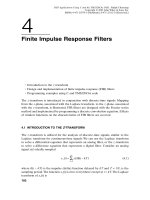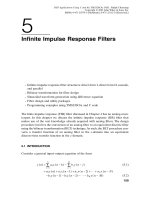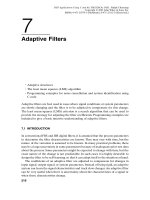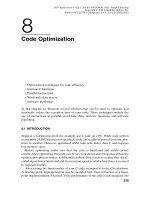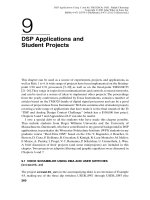DSP applications using C and the TMS320C6X DSK (P7)
Bạn đang xem bản rút gọn của tài liệu. Xem và tải ngay bản đầy đủ của tài liệu tại đây (222.39 KB, 23 trang )
7
Adaptive Filters
216
•
Adaptive structures
•
The least mean squares (LMS) algorithm
•
Programming examples for noise cancellation and system identification using
C code
Adaptive filters are best used in cases where signal conditions or system parameters
are slowly changing and the filter is to be adjusted to compensate for this change.
The least mean squares (LMS) criterion is a search algorithm that can be used to
provide the strategy for adjusting the filter coefficients. Programming examples are
included to give a basic intuitive understanding of adaptive filters.
7.1 INTRODUCTION
In conventional FIR and IIR digital filters, it is assumed that the process parameters
to determine the filter characteristics are known. They may vary with time, but the
nature of the variation is assumed to be known. In many practical problems, there
may be a large uncertainty in some parameters because of inadequate prior test data
about the process. Some parameters might be expected to change with time, but the
exact nature of the change is not predictable. In such cases it is highly desirable to
design the filter to be self-learning, so that it can adapt itself to the situation at hand.
The coefficients of an adaptive filter are adjusted to compensate for changes in
input signal, output signal, or system parameters. Instead of being rigid, an adaptive
system can learn the signal characteristics and track slow changes. An adaptive filter
can be very useful when there is uncertainty about the characteristics of a signal or
when these characteristics change.
DSP Applications Using C and the TMS320C6x DSK. Rulph Chassaing
Copyright © 2002 John Wiley & Sons, Inc.
ISBNs: 0-471-20754-3 (Hardback); 0-471-22112-0 (Electronic)
Introduction
217
Figure 7.1 shows a basic adaptive filter structure in which the adaptive filter’s
output y is compared with a desired signal d to yield an error signal e, which is
fed back to the adaptive filter. The coefficients of the adaptive filter are adjusted,
or optimized, using a least mean squares (LMS) algorithm based on the error signal.
We discuss here only the LMS searching algorithm with a linear combiner (FIR
filter), although there are several strategies for performing adaptive filtering. The
output of the adaptive filter in Figure 7.1 is
(7.1)
where w
k
(n) represent N weights or coefficients for a specific time n. The convolu-
tion equation (7.1) was implemented in Chapter 4 in conjunction with FIR filter-
ing. It is common practice to use the terminology of weights w for the coefficients
associated with topics in adaptive filtering and neural networks.
A performance measure is needed to determine how good the filter is. This
measure is based on the error signal,
(7.2)
which is the difference between the desired signal d(n) and the adaptive filter’s
output y(n). The weights or coefficients w
k
(n) are adjusted such that a mean squared
error function is minimized. This mean squared error function is E[e
2
(n)], where E
represents the expected value. Since there are k weights or coefficients, a gradient
of the mean squared error function is required. An estimate can be found instead
using the gradient of e
2
(n), yielding
(7.3)
which represents the LMS algorithm [1–3]. Equation (7.3) provides a simple but
powerful and efficient means of updating the weights, or coefficients, without the
need for averaging or differentiating, and will be used for implementing adaptive
filters. The input to the adaptive filter is x(n), and the rate of convergence and
accuracy of the adaptation process (adaptive step size) is b.
wn wn enxnk k N
kk
+
()
=
()
+
()
-
()
=-12 011b , ,...,
en dn yn
()
=
()
-
()
yn w nxn k
k
k
N
()
=
()
-
()
=
-
Â
0
1
Adaptive filter
d
e
xy
+
–
FIGURE 7.1. Basic adaptive filter structure.
218
Adaptive Filters
For each specific time n, each coefficient, or weight, w
k
(n) is updated or replaced
by a new coefficient, based on (7.3), unless the error signal e(n) is zero. After the
filter’s output y(n), the error signal e(n) and each of the coefficients w
k
(n) are
updated for a specific time n, a new sample is acquired (from an ADC) and the
adaptation process is repeated for a different time. Note that from (7.3), the weights
are not updated when e(n) becomes zero.
The linear adaptive combiner is one of the most useful adaptive filter structures
and is an adjustable FIR filter. Whereas the coefficients of the frequency-selective
FIR filter discussed in Chapter 4 are fixed, the coefficients, or weights, of the adap-
tive FIR filter can be adjusted based on a changing environment such as an input
signal. Adaptive IIR filters (not discussed here) can also be used. A major problem
with an adaptive IIR filter is that its poles may be updated during the adaptation
process to values outside the unit circle, making the filter unstable.
The programming examples developed later will make use of equations
(7.1)–(7.3). In (7.3) we simply use the variable b in lieu of 2b.
7.2 ADAPTIVE STRUCTURES
A number of adaptive structures have been used for different applications in
adaptive filtering.
1. For noise cancellation. Figure 7.2 shows the adaptive structure in Figure 7.1
modified for a noise cancellation application. The desired signal d is corrupted
by uncorrelated additive noise n. The input to the adaptive filter is a noise n¢
that is correlated with the noise n. The noise n¢ could come from the same
source as n but modified by the environment. The adaptive filter’s output y is
adapted to the noise n. When this happens, the error signal approaches the
desired signal d. The overall output is this error signal and not the adaptive
filter’s output y. This structure will be further illustrated with programming
examples using C code.
2. For system identification. Figure 7.3 shows an adaptive filter structure that can
be used for system identification or modeling. The same input is to an
unknown system in parallel with an adaptive filter. The error signal e is the
difference between the response of the unknown system d and the response
of the adaptive filter y. This error signal is fed back to the adaptive filter and
Adaptive filter
d + n
e
n′ y
+
–
FIGURE 7.2. Adaptive filter structure for noise cancellation.
Adaptive Structures
219
is used to update the adaptive filter’s coefficients until the overall output y =
d. When this happens, the adaptation process is finished, and e approaches
zero. In this scheme, the adaptive filter models the unknown system.This struc-
ture is illustrated later with three programming examples.
3. Adaptive predictor. Figure 7.4 shows an adaptive predictor structure which can
provide an estimate of an input. This structure is illustrated later with a pro-
gramming example.
4. Additional structures have been implemented, such as:
(a) Notch with two weights, which can be used to notch or cancel/reduce a
sinusoidal noise signal. This structure has only two weights or coefficients.
This structure is shown in Figure 7.5 and is illustrated in Refs. 1, 3, and 4
using the C31 processor.
(b) Adaptive channel equalization, used in a modem to reduce channel dis-
tortion resulting from the high speed of data transmission over telephone
channels.
Adaptive filter
d
e
x
y
+
–
Unknown
system
FIGURE 7.3. Adaptive filter structure for system identification.
input
IN1 = d(n)
IN2
e(n)
y(n)
+
–
Adaptive
filter
Primary input = d + n
e(n)
y(n)
y
2
(n)
y
1
(n)
x
2
(n)
x
1
(n)
+
–
Adaptive
filter
Reference
sinusoid
90°
Delay
FIGURE 7.4. Adaptive predictor structure.
FIGURE 7.5. Adaptive notch structure with two weights.
The LMS is well suited for a number of applications, including adaptive echo and
noise cancellation, equalization, and prediction.
Other variants of the LMS algorithm have been employed, such as the sign-error
LMS, the sign-data LMS, and the sign-sign LMS.
1. For the sign-error LMS algorithm, (7.3) becomes
(7.4)
where sgn is the signum function,
(7.5)
2. For the sign-data LMS algorithm, (7.3) becomes
(7.6)
3. For the sign-sign LMS algorithm, (7.3) becomes
(7.7)
which reduces to
(7.8)
which is more concise from a mathematical viewpoint because no multiplica-
tion operation is required for this algorithm.
The implementation of these variants does not exploit the pipeline features of
the TMS320C6x processor. The execution speed on the TMS320C6x for these vari-
ants can be slower than for the basic LMS algorithm, due to additional decision-
type instructions required for testing conditions involving the sign of the error signal
or the data sample.
The LMS algorithm has been quite useful in adaptive equalizers, telephone
cancelers, and so forth. Other methods, such as the recursive least squares (RLS)
algorithm [4], can offer faster convergence than the basic LMS but at the expense
of more computations. The RLS is based on starting with the optimal solution and
then using each input sample to update the impulse response in order to maintain
that optimality. The right step size and direction are defined over each time sample.
Adaptive algorithms for restoring signal properties can also be found in Ref. 4.
Such algorithms become useful when an appropriate reference signal is not avail-
wn
wn en xnk
wn
k
k
k
+
()
=
()
+
()
[]
=-
()
[]
()
-
Ï
Ì
Ó
1
b
b
if
otherwise
sgn sgn
wn wn en xnk
kk
+
()
=
()
+
()
[]
-
()
[]
1 b sgn sgn
wn wn en xnk
kk
+
()
=
()
+
()
-
()
[]
1 b sgn
sgn u
u
u
()
=
-<
Ï
Ì
Ó
10
10
if
if
у
wn wn enxnk
kk
+
()
=
()
+
()
[]
-
()
1 b sgn
220
Adaptive Filters
able. The filter is adapted in such a way as to restore some property of the signal
lost before reaching the adaptive filter. Instead of the desired waveform as a tem-
plate, as in the LMS or RLS algorithms, this property is used for the adaptation of
the filter. When the desired signal is available, the conventional approach such as
the LMS can be used; otherwise, a priori knowledge about the signal is used.
7.3 PROGRAMMING EXAMPLES FOR NOISE CANCELLATION AND
SYSTEM IDENTIFICATION
The following programming examples illustrate adaptive filtering using the least
mean squares (LMS) algorithm. It is instructive to read the first example even
though it does not use the DSK, since it illustrates the steps in the adaptive process.
Example 7.1: Adaptive Filter Using C Code Compiled with
Borland C/C++ (Adaptc)
This example applies the LMS algorithm using a C-coded program compiled with
Borland C/C++. It illustrates the following steps for the adaptation process using
the adaptive structure in Figure 7.1:
1. Obtain a new sample for each, the desired signal d and the reference input to
the adaptive filter x, which represents a noise signal.
2. Calculate the adaptive FIR filter’s output y, applying (7.1) as in Chapter 4 with
an FIR filter. In the structure of Figure 7.1, the overall output is the same as
the adaptive filter’s output y.
3. Calculate the error signal applying (7.2).
4. Update/replace each coefficient or weight applying (7.3).
5. Update the input data samples for the next time n, with a data move scheme
used in Chapter 4. Such a scheme moves the data instead of a pointer.
6. Repeat the entire adaptive process for the next output sample point.
Figure 7.6 shows a listing of the program adaptc.c, which implements the LMS
algorithm for the adaptive filter structure in Figure 7.1. A desired signal is chosen
as 2 cos(2npf/F
s
), and a reference noise input to the adaptive filter is chosen as
sin(2npf/F
s
), where f is 1kHz and F
s
= 8 kHz. The adaptation rate, filter order,
number of samples are 0.01, 22, and 40, respectively.
The overall output is the adaptive filter’s output y, which adapts or converges to
the desired cosine signal d.
The source file was compiled with Borland’s C/C++ compiler. Execute this
program. Figure 7.7 shows a plot of the adaptive filter’s output (y_out) converg-
ing to the desired cosine signal. Change the adaptation or convergence rate b to
0.02 and verify a faster rate of adaptation.
Programming Examples for Noise Cancellation and System Identification
221
222
Adaptive Filters
//Adaptc.c Adaptation using LMS without TI’s compiler
#include <stdio.h>
#include <math.h>
#define beta 0.01 //convergence rate
#define N 21 //order of filter
#define NS 40 //number of samples
#define Fs 8000 //sampling frequency
#define pi 3.1415926
#define DESIRED 2*cos(2*pi*T*1000/Fs) //desired signal
#define NOISE sin(2*pi*T*1000/Fs) //noise signal
main()
{
long I, T;
double D, Y, E;
double W[N+1] = {0.0};
double X[N+1] = {0.0};
FILE *desired, *Y_out, *error;
desired = fopen (“DESIRED”, “w++”); //file for desired samples
Y_out = fopen (“Y_OUT”, “w++”); //file for output samples
error = fopen (“ERROR”, “w++”); //file for error samples
for (T = 0; T < NS; T++) //start adaptive algorithm
{
X[0] = NOISE; //new noise sample
D = DESIRED; //desired signal
Y = 0; //filter’output set to zero
for (I = 0; I <= N; I++)
Y += (W[I] * X[I]); //calculate filter output
E = D - Y //calculate error signal
for (I = N; I >= 0; I--)
{
W[I] = W[I] + (beta*E*X[I]); //update filter coefficients
if (I != 0)
X[I] = X[I-1]; //update data sample
}
fprintf (desired, “\n%10g %10f”, (float) T/Fs, D);
fprintf (Y_out, “\n%10g %10f”, (float) T/Fs, Y);
fprintf (error, “\n%10g %10f”, (float) T/Fs, E);
}
fclose (desired);
fclose (Y_out);
fclose (error);
}
FIGURE 7.6. Adaptive filter program compiled with Borland C/C++ (adaptc.c).
Programming Examples for Noise Cancellation and System Identification
223
FIGURE 7.7. Plot of adaptive filter’s output converging to cosine signal desired.
FIGURE 7.8. Plot of adaptive filter’s output converging to cosine signal desired using
interactive capability with progam adaptive.c.
224
Adaptive Filters
Interactive Adaptation
A version of the program adaptc.c in Figure 7.6, with graphics and interactive
capabilities to plot the adaptation process for different values of b is on the accom-
panying disk as adaptive.c, compiled with Turbo or Borland C/C++. It uses a
desired cosine signal with an amplitude of 1 and a filter order of 31. Execute this
program, enter a b value of 0.01, and verify the results in Figure 7.8. Note that the
output converges to the desired cosine signal. Press F2 to execute this program again
with a different beta value.
Example 7.2: Adaptive Filter for Noise Cancellation (adaptnoise)
This example illustrates the application of the LMS criterion to cancel an undesir-
able sinusoidal noise. Figure 7.9 shows a listing of the program adaptnoise.c,
which implements an adaptive FIR filter using the structure in Figure 7.1. This
program uses a float data format. An integer format version is included on the
accompanying disk as adaptnoise_int.c.
A desired sine wave of 1500 Hz with an additive (undesired) sine wave noise of
312 Hz forms one of two inputs to the adaptive filter structure. A reference (tem-
plate) cosine signal, with a frequency of 312Hz, is the input to a 30-coefficient
adaptive FIR filter. The 312-Hz reference cosine signal is correlated with the
312-Hz additive sine noise but not with the 1500-Hz desired sine signal.
For each time n, the output of the adaptive FIR filter is calculated and the 30
weights or coefficients are updated along with the delay samples. The “error” signal
E is the overall desired output of the adaptive structure. This error signal is the
difference between the desired signal and additive noise (dplusn), and the adap-
tive filter’s output, y(n).
All signals used are from a lookup table generated with MATLAB. No external
inputs are used in this example. Figure 7.10 shows a MATLAB program adapt-
noise.m (a more complete version is on the disk) that calculates the data values for
the desired sine signal of 1500 Hz, the additive noise as a sine of 312Hz, and the ref-
erence signal as a cosine of 312 Hz.The appropriate files generated (on the disk) are:
1. dplusn: sine(1500Hz) + sine(312 Hz)
2. refnoise: cosine(312Hz)
Figure 7.11 shows the file sin1500.h with sine data values that represent the
1500-Hz sine-wave signal desired. The frequency generated associated with
sin1500.h is
The constant beta determines the rate of convergence.
fF
s
=
()()
=
()
=##of cycles of points Hz8000 24 128 1500


